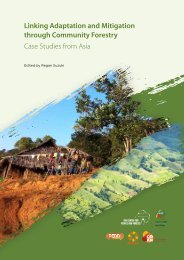Desktop Study on - Regional Climate Change Adaptation ...
Desktop Study on - Regional Climate Change Adaptation ...
Desktop Study on - Regional Climate Change Adaptation ...
You also want an ePaper? Increase the reach of your titles
YUMPU automatically turns print PDFs into web optimized ePapers that Google loves.
<str<strong>on</strong>g>Desktop</str<strong>on</strong>g> <str<strong>on</strong>g>Study</str<strong>on</strong>g><br />
adaptati<strong>on</strong> (2010). The adaptati<strong>on</strong> strategies<br />
suggested for government units focuses <strong>on</strong> water<br />
related practices, whereas the <strong>on</strong>es addressed for the<br />
community and household levels seem to emphasise<br />
<strong>on</strong> capacity building in l<strong>on</strong>g term disaster resp<strong>on</strong>se<br />
and in short term coping practices, respectively.<br />
Shown in Table 9 are some examples of the strategies<br />
at all levels.<br />
SUMMARY OF IDENTIFIED<br />
KEY GAPS, CONSTRAINTS<br />
AND CHALLENGES<br />
Water Sector<br />
Regardless of climate change effects, many<br />
parts of Ind<strong>on</strong>esia experience the reducti<strong>on</strong><br />
of the quantity and quality of water resources<br />
due to growing populati<strong>on</strong>, ec<strong>on</strong>omic activities,<br />
forest clearing, land use practices and improper<br />
disposal of waste. For example, reservoirs and<br />
p<strong>on</strong>ds provide water to <strong>on</strong>ly about 10% of the<br />
total existing irrigated area, and supply clean<br />
water to 37% of the urban populati<strong>on</strong> but<br />
<strong>on</strong>ly to 8% of the rural populati<strong>on</strong> (Republic<br />
of Ind<strong>on</strong>esia, 2007). This water shortage is<br />
expected to increase due to climate change,<br />
especially the decrease in rainfall. There<br />
are several adaptati<strong>on</strong> opti<strong>on</strong>s that have<br />
been suggested to fulfil the water demand<br />
increased from these human- and climateinduced<br />
water shortage, but these opti<strong>on</strong>s<br />
are of high c<strong>on</strong>cern since they may cause the<br />
sec<strong>on</strong>d and third c<strong>on</strong>sequences. For example,<br />
the use of groundwater is suggested as <strong>on</strong>e<br />
adaptati<strong>on</strong> opti<strong>on</strong> (Republic of Ind<strong>on</strong>esia,<br />
2007). Groundwater resources, however, are<br />
particularly shallow and are vulnerable in<br />
terms of quantity and quality, especially in<br />
the dry seas<strong>on</strong>, and the excessive extracti<strong>on</strong> of<br />
groundwater, mainly because of the industrial<br />
use, may lead to land subsidence that would<br />
result in increasing the risk for flood and the<br />
intrusi<strong>on</strong> of salt water (Republic of Ind<strong>on</strong>esia,<br />
2007).<br />
In additi<strong>on</strong>, despite the existing studies that<br />
dem<strong>on</strong>strates both human- and climate-related<br />
causes of water shortage and sea level rise, the<br />
suggested adaptati<strong>on</strong> strategies revolve around<br />
the opti<strong>on</strong>s that addresses scientific knowledge<br />
<strong>on</strong> the expected impacts of climate change, but<br />
not to emphasise <strong>on</strong> changing socio-ec<strong>on</strong>omic<br />
as well as ecological envir<strong>on</strong>ments. The<br />
Ministry of Envir<strong>on</strong>ment (2007) recommends<br />
reducing scientific uncertainties surrounding<br />
the climate change effects through the collecti<strong>on</strong><br />
of l<strong>on</strong>g-term historical data <strong>on</strong> hydrological and<br />
meteorological phenomena and validating all<br />
climatic models and techniques. Meanwhile,<br />
the sea level rise in Ind<strong>on</strong>esia is expected to be<br />
greater with c<strong>on</strong>tinuous coastal erosi<strong>on</strong>, which<br />
is actually associated with socio-ec<strong>on</strong>omic<br />
development such as the interrupti<strong>on</strong> of the<br />
al<strong>on</strong>g-shore sand transport through physical<br />
structures, circulating currents generated by<br />
seawalls, the decrease of sediment from rivers<br />
caused by c<strong>on</strong>structi<strong>on</strong> of many dams in the<br />
upstream regi<strong>on</strong>s, coral or sand mining and<br />
deforestati<strong>on</strong> of mangrove forests (Ministry of<br />
Envir<strong>on</strong>ment, 2007). However, these human<br />
activities that have partially affected the sea<br />
level rise are not embodied in the governmental<br />
policies yet.<br />
Agriculture and Food Security Sector<br />
Although informati<strong>on</strong> <strong>on</strong> ENSO forecasts is<br />
generally available in Ind<strong>on</strong>esia, the access to<br />
informati<strong>on</strong> is not well established yet so that<br />
farmers cannot take precauti<strong>on</strong>s measures<br />
before the draught events (Keil et al., 2008).<br />
Also, climate models that are accurate for<br />
mountainous regi<strong>on</strong>s such as Central Sulawesi<br />
need to be developed, addressing the local<br />
c<strong>on</strong>text.<br />
Moreover, most of the farmers from this regi<strong>on</strong><br />
rely <strong>on</strong> n<strong>on</strong>-technical irrigati<strong>on</strong> systems with an<br />
irregular supply of water and the cropping and<br />
irrigati<strong>on</strong> schedule at the village level is not well<br />
coordinated (ibid). The land with n<strong>on</strong>-technical<br />
irrigati<strong>on</strong> facilities often faces the droughtinduced<br />
reducti<strong>on</strong> of rice yield. Given that the<br />
access to credit or a high level of technical<br />
efficiency in their agricultural producti<strong>on</strong><br />
results in a higher level of drought resilience,<br />
the technical and financial assistances for the<br />
farmers should be taken into c<strong>on</strong>siderati<strong>on</strong>.<br />
In additi<strong>on</strong>, there are limited adaptive capacity<br />
of the farmers in certain upland regi<strong>on</strong>s whose<br />
soil cover is eroded due to erratic rainfall or<br />
drought, as well as lack of well-coordinated<br />
system of water distributi<strong>on</strong> from upstream to<br />
downstream areas, for which renders farmers<br />
in downstream more exposed to climate change<br />
effects especially during a l<strong>on</strong>g dry seas<strong>on</strong><br />
(UNDP Ind<strong>on</strong>esia, 2007).<br />
84

















